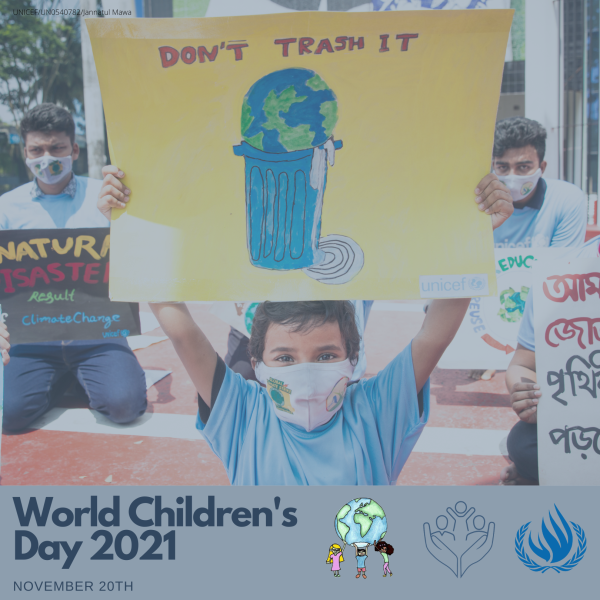
World Children's Day 2021 | Joint-Statement on the Centrality of Children in Climate Action

The Centrality of Children in Climate Action
World Children’s Day 2021
As COP 26, the 2021 United Nations Climate Change Conference ends, the world must grapple with how much still must be done to ensure a safe environment for our children and future generations. With little time left to slow the pace of climate change, there is an overwhelming and increasing fear that humanity may fail to resolve the climate crisis—the defining crisis of our time. The costs and consequences of our collective action and inaction will be felt most deeply by children – impacting their rights, protection, and well-being.
Approximately 1 billion children – nearly half the world’s children – live in countries considered to be high-risk due to extreme climate events, according to UNICEF’s Children’s Climate Risks Index. Wildfires, floods, droughts, famine, water scarcity and pandemics rank among the many risks children are and will be exposed to as a consequence of the climate crisis. Today, almost 160 million children are exposed to severe and prolonged droughts. By 2040, it is estimated that one in four children will be living in areas with extreme water shortages.
“Children and young people contribute the least to climate change, yet they suffer tremendously and often they suffer in silence.” Priyanka Lalla, Youth activist, Trinidad and Tobago
The evidence is alarming, and the consequences will only intensify. Already, around 38 million children see their education disrupted by the climate crisis each year and 90% of diseases resulting from the climate crisis are likely to affect children under the age of five. By 2025, a further 24 million children are projected to be undernourished. The climate crisis is increasingly a driver of forced migration and by 2050, there could be an additional 143 million migrants as a direct result. The climate crisis also contributes to many of the drivers of abuse, neglect, exploitation, and violence against children, such as poverty, conflict, and displacement.
Faced with such stark evidence, it is imperative that we take urgent and collective action and innovation with respect to the climate crisis to support the healthy development of all children as well as to protect the future and well-being of all young people.
We have heard the call from children and youth.
On this World Children’s Day, the Alliance, CERI and the Committee on the Rights of the Child call for State parties to the Convention on the Rights of the Child to:
- Ensure that children and their rights are protected as an integral part of all actions related to climate change and climate justice
- Mobilize resources to address risk and protective factors to prevent further harm to children
- Integrate and elevate the voices and engagement of children and youth – of all genders, abilities and backgrounds, by ensuring that they have access to information and the right to meaningful participation
- Ensure that children have access to justice and remedy in relation to climate change
- Promote climate justice for all children and youth, including by protecting ecosystem integrity for future generations
- Provide a safe and empowering context for child human rights defenders working on climate change and climate justice
Addressing the climate crisis will be the ultimate test of accountability to the world’s children
About the Authors:
The Committee on the Rights of the Child is a group of 18 independent experts that monitors implementation of the Convention on the Rights of the Child. It is currently working on a general comment on children’s rights and the environment with a special focus on climate change that will provide authoritative guidance to States parties on their obligations relating to climate change and children’s rights, including with regard to mitigation and adaptation, and clarify the relationship between children’s rights and environmental protection.
The Children’s Environmental Rights Initiative (CERI) is a global coalition working to ensure children’s right to a safe and healthy environment. CERI is a team of activists, technical experts, policymakers and young people from around the world that have long fought for children and the environment, having come together, bringing their greatest strengths, to make sure that children’s fundamental right to a safe and healthy environment is recognized and fulfilled.
The Alliance for Child Protection in Humanitarian Action (the Alliance), is a global network of operational agencies, academic institutions, policymakers, donors and practitioners, who work on protection of children affected by humanitarian crises. The Alliance facilitates inter-agency technical collaboration and sets technical standards for the sector. In its recently launched 2021-2025 Strategic Plan, the Alliance looks ahead to “play an important leadership role within the child protection sector on climate crisis, and contribute a child protection lens to climate actions and climate justice.”
Please find the official statement attached below.
- 165 views
